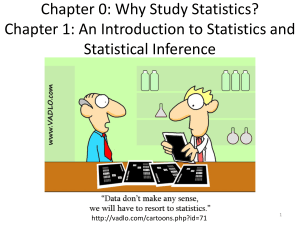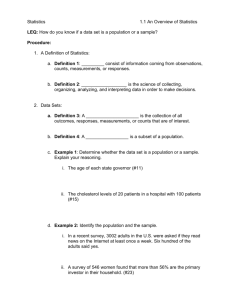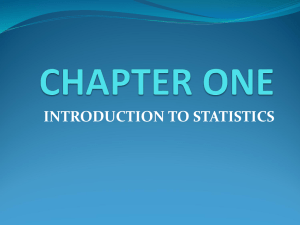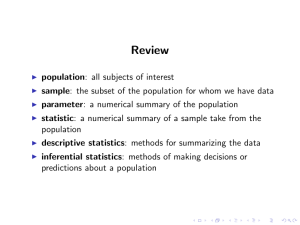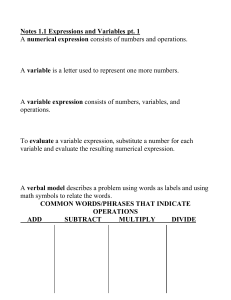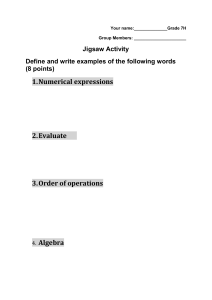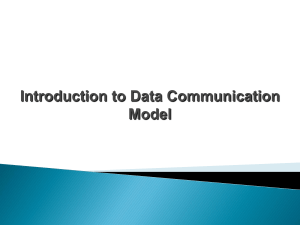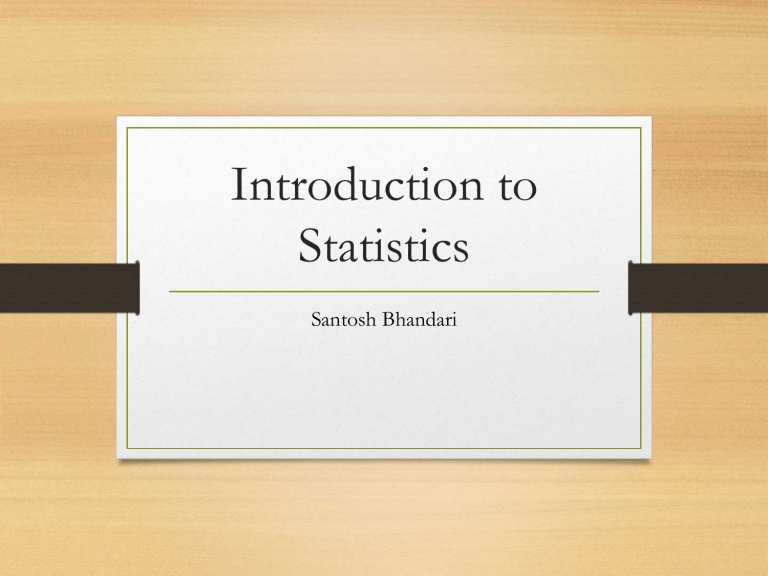
Introduction to Statistics Santosh Bhandari Why study statistics? 1. Data are everywhere 2. Statistical techniques are used to make many decisions that affect our lives 3. No matter what your career, you will make professional decisions that involve data. An understanding of statistical methods will help you make these decisions efectively. etc Meaning • • • • The term “Statistics” from latin word “status” Italian words “statista” means Statement German worlds “statistik” means political State Statistics is concerned with scientific methods for collecting, organizing, Summarizing, presenting and analyzing data as well as deriving valid conclusions and making reasonable decisions on the basis of this analysis. Francis Galton, Bernoulli, Karl Person, Ronald Fisher etc are main contribution to develop the statistics'. Definition of Statistics in singular sense Statistics as the science of counting or science of average (A.L. Bowley) Statistics as the science of estimates and probabilities (Boddington) Statistics is the science which deals with the method of collection, classifying, presenting, comparing and interpreting numerical data collected to throw some light in any sphere of enquiry (Selligman). Statistics may be regarded as a body of methods for making wise decision in the face of uncertainty(Wallis and Roberts ). Statistics may be defined as the science of collections, presentation, analysis and interpretation of the data(Croxton & Cowden). Definition of Statistics in plural sense Statistics are the classified facts representing the conditions of the people in given state(Webster). Statistics are numerical statement of facts in any department of enquiry placed in relation to each others(Bowley). Statistics may be defined as the aggregate of fact, affected to a marked extent, by multiplicity of causes, numerically expressed, enumerated or estimated according to a reasonable standard of accuracy, collected a systematic manner for predetermined purpose and placed in relation to each others(Prof. Horace Secrist). Use & scope of Statistics • • • • • • • • • • • Planning Economics Business & Management Industry Physical sciences Biological sciences Social sciences Information Technology Agriculture Insurance Education & Psychology Functions of Statistics • • • • • • • • Simplifies complexity Facilities of comparison To help Formulation of policies To help Classification of data Help in formulating and testing hypothesis To help predicting future trends Test the law of others science Enlarge individual experience Thus main function of statistics are Condensation , Comparison , Forecasting, Estimation . Limitation of Statistics • Does not deals with individuals • Statistics does not study the qualitative phenomena. • Statistics laws are not exact • Statistics is only means • Statistics can be misused Types of Statistics Theoretical or Mathematical Descriptive Applied Inferential Descriptive Statistics • It deals with methods which help in estimating the characteristics of a population or making decisions concerning a population on the basis of the sample results. Sample and population are the two relative terms. A Population is treated as universe and a sample is fraction or segment of the universe. • Summary and favor of distribution. • Tabular, graphical or numerical are termed are used like wise Average, rates, ratios etc. • Measure of central tendency, skewness, kurtosis etc. Inferential Statistics It means to describe the data and consists of the methods and techniques used in the collection, organization, presentation and analysis of data in order to describe the various features and characteristics of such data. These can either be graphical or computational. In this, nothing can be inferred from the data nor can decision be made or conclusion drawn. Applied Statistics • This consists of massive application of theoretical or mathematical. • The statistical tools and methods are used in order to solve many more practical problems in diversified area. • Applied statistics has played very important role in decision making problem as well. Types & Sources of Data • All statistical analysis begins by identifying the source of the data. Among the important sources of data are published sources, experiments, and surveys. • Statistical data are mainly depending the sources of two types A. Primary Data B. Secondary Data Primary Data • Fresh and original data, which are collected and recorded by the investigator or researchers for the specific purpose. • Following method are using the collect the primary data; a) Direct Personal Interview b) Indirect oral interview c) Information through correspondents d) Mailed questionnaire e) Schedules sent through enumerators Secondary data • Data are already collected • The sources of data are 1. Publish Sources(Reports and official publications, Semi-official publication, un-official or private publicaion) 2. Unpublished Sources Precautions in the use of secondary Data • Suitability • Reliability • Adequacy Thank you all
